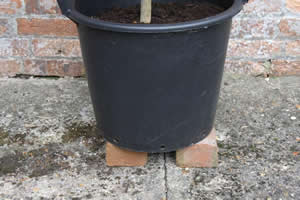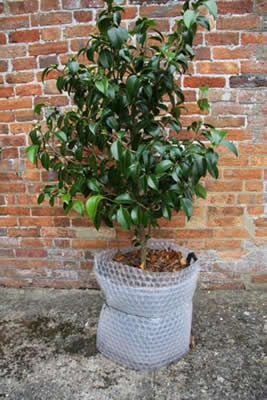|
|
|
How To Protect Camellias For Winter Last Updated: 11/11/2011 |
|
So, we've talked about how camellias become damaged by winter, particularly how frost can kill roots that are restricted in containers, putting them permanently out of action, but what can you do to prevent it? As always prevention is the key because there is no cure for roots that have been frozen for more than a day or two. Th If you do not have an unheated shed, garage, porch, conservatory etc. then each pot can be insulated. Start with your tub and ensure that the base is raised off the ground. This encourages good drainage so that water does not occupy the air spaces that surround the roots in the compost. It also prevents contact with the frozen ground. 2 bricks are fine to use, as are chunks of wood. Anything that will raise the pot by a couple of inches or so.
Next, place a good thick layer of freshly fallen leaves/bracken/coarse woodchip mulch; anything that has plenty of insulating air within it, on the top of the pot. Its surprising how an apparently dormant camellia needs water during the winter, so rainwater and perhaps water from a can or hose must be able to percolate to the roots during warmer, drier spells. A top-up of leaves etc may be necessary as winter progresses, after all its those late frosts that so often cause the worst damage. Finally place your pots in a sheltered position away from winter sun and wind which, if combined with freezing temperatures, can cause damage not only to roots but also to leaves and those precious flower buds. If a sheltered position cannot be provided it is a good idea to wrap the "above ground" parts of your camellia in horticultural fleece. This is particularly beneficial to young plants, especially those carrying a load of flower buds as it reduces the risk of both bud drop and bark splitting that can be caused by freezing temperatures. Having given your camellias such TLC its time to sit back and relax--- but do check the compost every now and again and give water in the morning on a warmish day. |
 e answer is simple, quick and very very easy. Keep an eye on the weather forecast and provide frost protection before the first frost. Theres nothing worse than watching an unexpectedly prolonged cold spell set in and the frost making its way deeper and deeper into the compost in which your poor captive camellias are sitting.
e answer is simple, quick and very very easy. Keep an eye on the weather forecast and provide frost protection before the first frost. Theres nothing worse than watching an unexpectedly prolonged cold spell set in and the frost making its way deeper and deeper into the compost in which your poor captive camellias are sitting. Next, wrap your pot in a double layer of polythene bubble wrap, preferably the sort with big bubbles. Its easy to buy in office stationery stores. A couple of layers will provide enough insulation for the average winter but use as much as you like-- we are all for peace of mind !Tie this in place with garden twine or string.
Next, wrap your pot in a double layer of polythene bubble wrap, preferably the sort with big bubbles. Its easy to buy in office stationery stores. A couple of layers will provide enough insulation for the average winter but use as much as you like-- we are all for peace of mind !Tie this in place with garden twine or string.